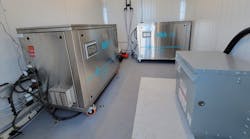Tom Palkon, director of product certification for the Water Quality Association (WQA), started 11 years ago as a chemist in WQA’s testing laboratory and has been overseeing its Gold Seal Certification Program for the past 10 of those years. The program offers certification of products and chemicals that contact drinking water, and was developed nearly 50 years ago. It’s been growing fast during Palkon’s tenure.
In addition to managing the Gold Seal Program’s operations, the Chicago-area native oversees its sales and marketing department, quality control staff and training programs. He’s also directing the current expansion of the WQA lab, located in the WQA headquarters building in Lisle, IL.
Palkon holds an undergraduate degree in biology from the University of Illinois and a master’s in business administration from the Keller Graduate School of Management.He interacts with everyone from CEOs of large equipment manufacturers to installers working in small dealerships. "It’s a joy working with such a variety of professionals," he told Water Technology® in this recent interview:
Water Technology: Tell us how you became interested in water treatment and product certification.
Tom Palkon: I never knew that I had an interest in water until I took a chemistry position in WQA’s product testing laboratory. While attending college, I had always planned to attend medical school. After graduation, I accepted the position with WQA in an effort to begin saving money while I studied for the medical school administration test (MCAT).
After I worked in the laboratory for a few months I noticed that the industry needed additional resources for testing and certifying products. I made it my personal goal to improve and expand WQA’s Gold Seal Certification Program to fill the void.
WT: What do you do as director of product certification for WQA?
TP: I have a variety of responsibilities that ensure the Gold Seal Program continues to grow, offers fair testing and certification fees, maintains third–party independence, operates under strict quality assurance parameters, and protects public health and safety.
The program has three operational departments: Certification, Laboratory and Facility Assessment. The Laboratory is responsible for product testing; the Facility Assessment department is responsible for conducting factory inspections of certified companies; and the Certification department ensures that all WQA–certified products meet the Gold Seal Program’s Certification Policies. One of the most important roles I have is to ensure each of the departments is well-managed. I am very fortunate to have an extremely hard-working, dedicated staff of professionals.
I also manage the Gold Seal Program’s sales and marketing department, quality control staff, and training programs. Other responsibilities include participation in [industry] task groups, standards–writing activities, and trade shows and conferences.
WT: Tell us what the WQA lab does and who uses its services.
TP: WQA’s Gold Seal Program tests and certifies products to a variety of industry standards. These certifications are used by companies for regulatory compliance, as marketing tools and for consumer assurance of product quality.
A variety of companies use the Gold Seal Program. The majority of our clients produce drinking water treatment products: softeners, RO systems, filters, ultraviolet devices, shower filters and distillers.
In 2005, the Gold Seal Program also began testing and certifying drinking water components and additives; it is now the fastest-growing sector of the Gold Seal Program. [These products] include pipe, plumbing products, media, faucets, fittings, pumps, chlorine, phosphates, coagulants and more. The Gold Seal Program also covers products such as equipment used in food applications, bottled water, the pool and spa industry, and the US Environmental Protection Agency’s WaterSense Program.
WT: There’s been increased attention lately on point–of–use/point–of–entry (POU/POE) products’ contaminant removal capabilities. What’s new in this area?
TP: Our industry has received a lot of attention this year. As always, companies are continually improving their products’ reduction capabilities of water contaminants and developing new products in response to emerging contaminants.
In the 11 years I have worked in this industry, I can’t remember a time when the industry did not have a product or the ability to modify a product to remove a new contaminant that has been brought forward through the media.
WT: There was some talk that a task force would be formed to revise NSF/ANSI 53 and 58 standards to include perfluorochemicals (PFC) reduction test parameters.
TP: PFC reduction capabilities [have not been added yet] to the NSF/ANSI drinking water treatment unit standards. The next standards writing joint committee meeting will take place in November. During that meeting, I’m sure that PFCs will be discussed in detail and most likely a task force will be formed to begin the process.
WT: Elsewhere in this issue, Michael Convery of the Minnesota Department of Health (MDH) describes the MDH’s recent evaluation of POU devices for removal of PFCs. Tell us WQA’s role in this study.
TP: [The study] demonstrated that our industry currently has products that can remove PFCs from drinking water, which was great news for consumers living in Minnesota. MDH’s study included two parts: removal capabilities in laboratory testing and how the products actually perform on municipal supplies contaminated with PFCs in the field.
WQA’s role was to perform testing of POU products in the laboratory. WQA tested a variety of reverse osmosis (RO) and activated carbon products to the MDH protocol to determine which products could remove PFCs under laboratory conditions. The results of this initial study were used to choose products that would also be used in phase II of the study, to ensure they also removed PFCs from contaminated sources in Minnesota.
WT: In terms of POU/POE removal of pharmaceuticals and endocrine–disrupting compounds (EDCs), what’s next?
TP: At this time the media continues to demonstrate that municipal water, groundwater and even some bottled water contain low levels of pharmaceuticals and EDCs. Therefore, I don’t feel that this issue is going away anytime soon.
Some additional positive news is that initial studies demonstrate that POU filtration has shown to remove some of these contaminants. The Task Group [looking at developing a standard for pharmaceutical and EDC removal] has met via conference call a few times recently. It is still a very difficult task to incorporate pharmaceuticals or EDCs into the current product certification standards, for several reasons:
First, we don’t know if these part–per–trillion (ppt) levels are even harmful in drinking water.
Second, there are hundreds of pharmaceuticals and EDCs being discovered in drinking water. We typically test each one individually under the current test protocols. The task group needs to find a surrogate contaminant that can be used to represent a reasonable worst–case for a list of pharmaceuticals and EDCs to make the protocol cost–effective.
Third, we know that consumers do not want to consume pharmaceutical or EDCs from their drinking water, but analytical technology is incapable of detecting to 0.00. Therefore, what do we set the allowable level in drinking water that can be detected by instruments and methods available today?
WT: You have said that while manufacturers are hopeful for a published standard for removal of pharmaceuticals and EDCs, it would "cost too much" to make the claim. Tell us more.
TP: If a company wanted to claim that their product removes estrogen from water it would cost approximately $100,000 to perform the evaluation of the product for estrogen removal. This is the cost for claiming one pharmaceutical. Unless a surrogate pharmaceutical or EDC can be used, the costs for testing individual claims are just too high.
WT: What’s the best way for POU/POE water treatment professionals to address consumer concern regarding PFCs, meds–in–water and other emerging contaminants?
TP: I’m sure frontline professionals are running into consumers asking this question all the time. This is one reason WQA published its "FACT SHEET: Pharmaceuticals in Water." This fact sheet is a great resource that can be used by frontline sales professionals to explain what the industry knows about pharmaceuticals in water.
WT: What’s the status of the WQA lab expansion?
TP: [It’s] on schedule. The project should be complete in January 2009. To help cover increased demand in the WQA Gold Seal Program, the board has approved expanding into 7,000 square feet of the lower level of WQA’s international headquarters. The expansion will more than double the testing capacity for POU devices. The new area will house an additional 12 fully automated test benches that will be used to evaluate RO and POU filters.
WQA’s board is [also] reviewing the concept of offering a water analysis program for dealers and consumers.

